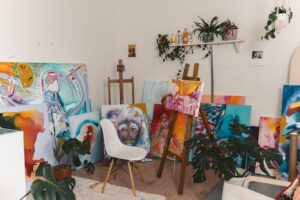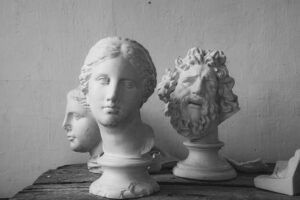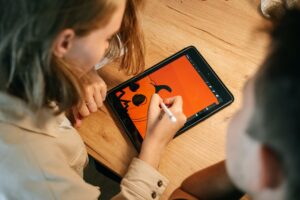Art has been an integral part of human civilization for centuries, serving as a medium for expression, communication and creativity. From cave paintings to modern-day installations, art has evolved with the times but its impact on our emotions and behavior remains constant. In this blog post, we delve into the fascinating world of the psychology of art and explore how it affects us in ways beyond just aesthetic pleasure. So fasten your seatbelts as we take you on a journey through the history, types and benefits of art while uncovering its profound psychological effects on our minds and bodies!
What is art?
Art is a universal form of expression that can be found in every culture, throughout history. It encompasses a broad range of creative activities including painting, sculpture, music, literature, dance and more. One of the defining characteristics of art is its ability to evoke emotions and stimulate our senses.
Artists use their creativity to communicate ideas and tell stories through various mediums like canvas or paper. The interpretation of art can be subjective since everyone has their own unique perspective on what they see or hear. What one person considers as beautiful might not resonate with another person.
Despite this subjectivity, there are still certain elements that make up great works of art such as composition and technique which transcend cultures and time periods. Art also serves different purposes for different people – it can educate us about history or social issues while providing an outlet for emotional expression.
Ultimately, the definition of art may vary depending on who you ask but it remains an essential part of human life – providing beauty, meaning and inspiration to those who seek it out.
The different types of art
Art comes in various forms and mediums, each with its own unique style, technique and purpose. One of the most common types of art is visual art, which includes paintings, sculptures and drawings. Visual art aims to create a visual representation of an idea or emotion that can be appreciated by anyone regardless of language or culture.
Another popular type of art is performing arts, such as music, dance and theater. Performing arts involve live performances before a live audience with a focus on expression through movement or sound. It often involves collaboration among artists working together to bring their vision to life.
Literary arts include poetry, novels and short stories which are written works that use words as their medium for expression. They aim to tell a story in prose while evoking emotions and ideas from the reader’s imagination.
Digital art is also becoming increasingly popular today thanks to technology advancements. This type of art uses digital tools like software programs to produce images that convey different meanings.
Regardless of the form it takes or how it’s produced, every artwork has something unique about them that captures our emotions and influences our behavior in one way or another.
The history of art
The history of art is as fascinating and rich as the art itself. It spans thousands of years, from prehistoric cave paintings to contemporary installations. Art has always been a way for humans to express themselves creatively, communicate ideas, beliefs and emotions.
The earliest known form of art dates back to around 40,000 BCE when early human beings created intricate drawings on the walls of their caves. These paintings depicted animals, hunting scenes and religious rituals.
As civilizations developed across the world, so did their styles of art. The Ancient Egyptians created elaborate hieroglyphics while Greeks and Romans produced marble sculptures that are still admired today.
During the Renaissance period in Europe (14th-17th century), artists like Leonardo da Vinci and Michelangelo made significant strides in painting and sculpture techniques which marked a turning point in Western art history.
Art movements such as Impressionism (19th century) challenged traditional notions of realism with bold colors and loose brushstrokes while Surrealism (20th century) explored the subconscious mind through dream-like imagery.
Today’s contemporary artists continue to push boundaries by experimenting with new mediums such as digital technology or performance art.
Art has played an important role throughout human history both aesthetically and culturally. From ancient cave dwellers to modern-day creatives – each generation has left its mark on this wonderful medium that we call “art.”
The psychological effects of art
Art is not just a visual form of expression, it has been proven to have numerous psychological effects on our minds and emotions. When we view or engage with art, our brains release dopamine which triggers feelings of pleasure and reward. This can lead to reduced stress levels and improved mental health.
Moreover, different types of art can evoke different emotions in us. For example, a painting depicting a serene landscape may calm us down while an abstract piece may leave us feeling confused or intrigued.
In addition to the emotional benefits, interacting with art can also enhance cognitive abilities such as critical thinking and problem-solving skills. It allows us to think outside the box and see things from new perspectives.
Art therapy is another way in which art can have significant psychological effects. It has been used as a therapeutic tool for individuals struggling with mental health issues such as anxiety or depression.
The psychological effects of art are undeniable. Whether it’s viewing a masterpiece at a museum or engaging in your own artistic practice, incorporating more art into your life could have numerous positive impacts on your mind and well-being.
The benefits of art
Art has been an integral part of human civilization since ancient times. It serves as a medium through which we can express our thoughts, emotions and ideas. Apart from being a creative outlet, art also provides numerous benefits to our mental health and well-being.
One of the most significant benefits of art is its ability to reduce stress and anxiety. Engaging in artistic activities such as painting, drawing or sculpting helps us focus on the present moment, allowing us to forget about our worries and troubles for a while.
Art has also been shown to improve cognitive function and memory retention in individuals who regularly participate in it. Creating art requires both analytical thinking and creativity, which strengthens neural pathways within the brain responsible for cognition.
In addition to that, art therapy has become increasingly popular as a means of promoting emotional healing among individuals experiencing psychological distress or trauma. The therapeutic benefits of creating visual arts have been found effective in treating conditions like depression, post-traumatic stress disorder (PTSD), anxiety disorders etc.
Moreover, exposure to different forms of art can broaden one’s perspective towards life by fostering empathy and understanding towards others’ experiences. Art can serve as a powerful tool for social commentary on issues ranging from politics to culture – leading people towards meaningful conversations that promote positive change in society.
Engaging with various forms of art offers numerous physical & mental health advantages along with enriching cultural experiences- making it an essential aspect contributing positively towards holistic human growth
The psychology of art
The psychology of art is a fascinating subject that delves into how our brains perceive and process visual stimuli. Art has been around for millennia and it continues to captivate us with its beauty, complexity, and diversity.
One of the key aspects of the psychology of art is how it affects our emotions. When we look at a piece of art, our brain releases dopamine – a neurotransmitter associated with pleasure – which makes us feel good. This emotional response can be intense or subtle depending on the individual and their personal experiences.
Another important aspect is how art influences our behavior. Studies have shown that exposure to certain types of artwork can affect decision-making processes, including risk-taking behaviors. Moreover, viewing certain colors in artwork can impact mood regulation as well as cognitive performance.
It’s also worth noting that different forms of art may have varying psychological effects on individuals due to factors such as cultural background or personal preferences. For instance, some people may find abstract paintings more appealing than realistic ones because they allow for greater interpretation and imagination.
The psychology of art reveals just how powerful this medium can be in shaping human experience on both an emotional and behavioral level.
How art affects our emotions and behavior
Art has a compelling way of affecting our emotions and behavior by tapping into our subconscious mind. It can evoke feelings of joy, sadness, anger or peace depending on the piece of art and the viewer’s individual experiences.
For example, viewing a painting with bright colors and cheerful imagery can uplift one’s mood and bring about positive emotions. On the other hand, darker pieces may elicit negative emotions such as fear or melancholy.
Art also has a transformative effect on our behavior by inspiring creativity and imagination. When we engage with art, it allows us to think outside the box and challenge conventional ways of thinking.
Moreover, creating art can be an effective form of therapy that helps individuals deal with emotional trauma or stress. By channeling their thoughts onto canvas or paper through various mediums like painting or drawing, they can express themselves in ways that may not have been possible otherwise.
Whether we are viewing or creating art, it has an undeniable impact on our emotional well-being and cognitive function.
Conclusion
Art is not just a form of creative expression but also has significant psychological effects on our emotions and behavior. It can evoke different feelings in individuals and even influence their mental state, such as reducing stress or anxiety. Moreover, engaging with art can lead to improved cognitive abilities and enhanced problem-solving skills.
Through the ages, humans have created various forms of art that reflect their society’s culture and beliefs. From cave paintings to modern digital media, artists continue to push boundaries by expressing themselves through different mediums.
As we gain a better understanding of the psychology behind art appreciation, we can use its benefits for therapy or personal growth. Whether it’s visiting an exhibition or creating your artwork, exploring the world of art provides endless opportunities for emotional connection and self-exploration.
Therefore, let us embrace this powerful tool that touches our hearts and minds alike – The Psychology of Art!








